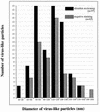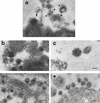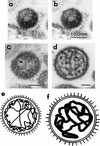Fine structure and morphogenesis of Borna disease virus
- PMID: 9847384
- PMCID: PMC103885
- DOI: 10.1128/JVI.73.1.760-766.1999
Fine structure and morphogenesis of Borna disease virus
Abstract
Borna disease virus (BDV), a negative nonsegmented single-stranded RNA virus, has not been fully characterized morphologically. Here we present what is to our knowledge the first data on the fine ultrastructure and morphogenesis of BDV. The supernatant of MDCK cells persistently infected with BDV treated with n-butyrate contained many virus-like particles and more BDV-specific RNA than that of untreated samples. The particles were spherical, enveloped, and approximately 130 nm in diameter; had spikes 7 nm in length; and reacted with BDV p40 antibody. A thin nucleocapsid, 4 nm in width, was present peripherally in contrast to the thick nucleocapsid of hemagglutinating virus of Japan. The BDV particles reproduced by budding on the cell surface.
Figures





Similar articles
-
A single-tube RT-PCR method for the detection of Borna disease viral genomic RNA.Jpn J Vet Res. 1998 Nov;46(2-3):73-81. Jpn J Vet Res. 1998. PMID: 10093417
-
Virus-like particles in MDCK cells persistently infected with Borna disease virus.Virus Res. 1994 Sep;33(3):261-8. doi: 10.1016/0168-1702(94)90107-4. Virus Res. 1994. PMID: 7985412 Free PMC article.
-
Rabies and borna disease. A comparative pathogenetic study of two neurovirulent agents.Lab Invest. 1993 Mar;68(3):285-95. Lab Invest. 1993. PMID: 8450648
-
[Demonstration on Borna disease virus in patients with chronic fatigue syndrome].Nihon Rinsho. 1997 Nov;55(11):3064-71. Nihon Rinsho. 1997. PMID: 9396313 Review. Japanese.
-
The neuropathogenesis of Borna disease virus infections.Intervirology. 1997;40(2-3):185-97. doi: 10.1159/000150545. Intervirology. 1997. PMID: 9450235 Review.
Cited by
-
ICTV Virus Taxonomy Profile: Bornaviridae.J Gen Virol. 2021 Jul;102(7):001613. doi: 10.1099/jgv.0.001613. J Gen Virol. 2021. PMID: 34227935 Free PMC article.
-
Borna disease virus nucleoprotein interacts with the CDC2-cyclin B1 complex.J Virol. 2003 Oct;77(20):11186-92. doi: 10.1128/jvi.77.20.11186-11192.2003. J Virol. 2003. PMID: 14512566 Free PMC article.
-
Model membrane platforms for biomedicine: case study on antiviral drug development.Biointerphases. 2012 Dec;7(1-4):18. doi: 10.1007/s13758-011-0018-2. Epub 2012 Feb 11. Biointerphases. 2012. PMID: 22589061 Free PMC article. Review.
-
Structural comparisons of the nucleoprotein from three negative strand RNA virus families.Virol J. 2007 Jul 10;4:72. doi: 10.1186/1743-422X-4-72. Virol J. 2007. PMID: 17623082 Free PMC article.
-
Borna disease virus glycoprotein is required for viral dissemination in neurons.J Virol. 2003 Nov;77(22):12222-31. doi: 10.1128/jvi.77.22.12222-12231.2003. J Virol. 2003. PMID: 14581559 Free PMC article.
References
-
- Bode L, Riegel S, Ludwig H, Amsterdam J D, Lange W, Koprowski H. Borna disease virus-specific antibodies in patients with HIV infection and with mental disorders. Lancet. 1988;ii:689. - PubMed
-
- Bode L, Riegel S, Lange W, Ludwig H. Human infections with Borna disease virus: seroprevalence in patients with chronic diseases and healthy individuals. J Med Virol. 1992;36:309–315. - PubMed
-
- Bode L, Ferszt R, Czech G. Borna disease virus infection and affective disorders in man. Arch Virol Suppl. 1993;7:159–167. - PubMed
-
- Bode L, Durrwald R, Ludwig H. Borna virus infections in cattle associated with fatal neurological disease. Vet Rec. 1994;135:283–284. - PubMed
-
- Bode L, Steinbach F, Ludwig H. A novel marker for Borna disease virus infection. Lancet. 1994;343:297–298. - PubMed
MeSH terms
Substances
LinkOut - more resources
Full Text Sources

